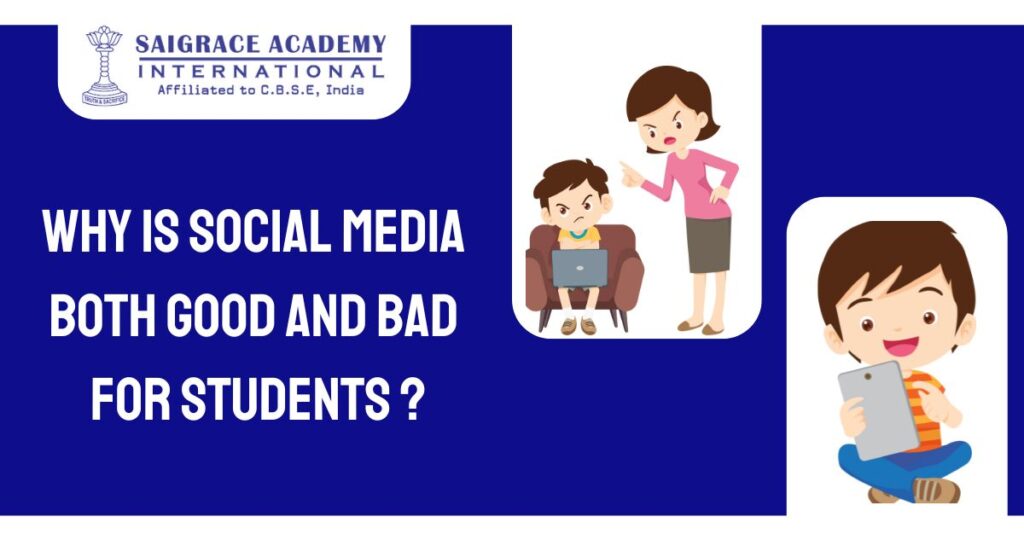
Social media plays an essential role as students incorporate it into their daily lives during the current digital era. Using Facebook, Instagram, Twitter, and TikTok as platforms, students gain access to creative spaces that combine interaction opportunities with information exchange.
The benefits of social media for students include it significantly affects student communication practices and modifies their educational and social understanding of the world. Social media supports connection-making between people and shares educational materials yet creates conditions that negatively impact students’ mental well-being and schoolwork achievement. Students together with educators and parents need to understand social media’s dual characteristics because this knowledge will help them handle the complex digital environment more competently.
Student interactions with social media platforms deliver an extensive range of content that simultaneously motivates and overloads them. Social media usage by students offers advantages such as improved verbal abilities, exposure to multiple viewpoints, and combined educational experiences. On the other hand, students face major problems that affect their mental well-being cyberbullying and mental distress, and the need to perform the way they present themselves online.
The following article analyzes the impact of social media on students from multiple perspectives, assessing both its positive aspects and its negative effects on students.
The Positive Impact of Social Media on Students
1. Enhanced Communication and Collaboration
Social media provides students with an essential benefit through enabling effortless interactions with both teachers and classmates. The messaging applications WhatsApp and other platforms assist students in collaborating on projects by sharing documents and getting quick responses from fellow students and teachers. The immediate connection capabilities build both community and support networks that improve educational experiences.
2. Access to Information and Resources
The internet has become an extensive platform that stores information. Through educational accounts, students can join study groups to get access to worldwide expert tutorials and lectures. By making knowledge freely accessible, students can learn about subjects beyond their classroom curriculum so they develop continuous learning habits. Social media enables students to obtain updated information across different fields, current trends, and worldwide developments.
3. Opportunities for Creativity
Social media platforms including Instagram, TikTok, and YouTube serve as creative expressive platforms for student users. Through various creative fields like photography, writing, video editing & more, students can display their artwork and gather global comments. Students gain crucial new skills that companies value in today’s labor market through these experiences which simultaneously grow their self-confidence.
4. Support Networks
Students benefit significantly from the emotional support that social media provides them. Users can join networks of people who understand their situations because they face the same academic problems, mental health difficulties, or personal struggles. Stressed-out students discover a safe platform through online support communities to express themselves and receive help from others.
The Negative Impact of Social Media on Students
1. Cyberbullying and Harassment
Social media improves life but also serves as a place where negative relations grow. The issue of cyberbullying poses a danger because students tolerate harassment and pressure through online interactions. The unknown identity factor of social media platforms enables bullies to worsen causing notable emotional pain for their targets. Social media negatively impacts students through damaging patterns that reduce their self-confidence along with their mental state.
2. Mental Health Issues
Social media’s effect on mental health shows multiple layers of difficulty. The benefits of support from social media networks directly differ from their potential negative impact which leads to increased symptoms of depression, loneliness, and anxiety. Students normally compare their situations to others which results in a sense of weakness and lowered self-worth. The need to show a flawless life on social platforms creates huge pressure that damages mental wellness.
3. Distraction and Reduced Productivity
The use of social media causes significant problems that impact student academic performance. The frequent pop-up alerts, notifications, and updates distract students from their studies and cause interruptions which result in lower academic productivity. The double pressure between education responsibilities and online engagements causes students to perform poorly in their studies while experiencing high levels of stress.
4. Privacy Concerns
Students commonly post their details online although they lack complete awareness of the privacy outcomes. Insufficient knowledge about online risks leads to privacy breakings that produce possible lasting outcomes. Student online activities surpass direct interactions since their digital paths can significantly impact their opportunities including education admissions processes and professional opportunities.
Conclusion
The impact of social media on Students generates simultaneous advantages and challenges. Social media functions as a tool that combines positive effects on communication together with creativity development and resource accessibility but simultaneously creates mental health challenges plus academic performance declines. Students who wish to operate effectively in social media space must find the right balance between its positive and negative aspects.
The educational team at Sai Grace Academy acknowledges how important it is to provide students with essential knowledge for growing in the digital environment. Our education model supports complete student development because it builds both academic talent and mental toughness and analytical abilities students need for life’s obstacles. We establish an environment which gives power to students to make educated decisions regarding mental health and social media to maintain their well-being together with academic achievements.

